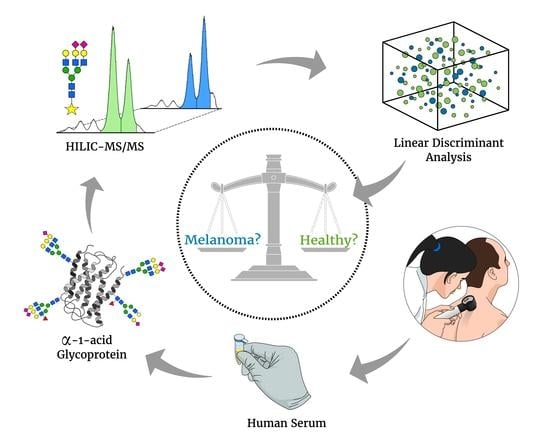Altered Glycosylation of Human Alpha-1-Acid Glycoprotein as a Biomarker for Malignant Melanoma
Abstract
:1. Introduction
2. Results and Discussion
2.1. HILIC-MS/MS
2.2. Statistical Analysis of Clinical Samples
3. Materials and Methods
3.1. Materials
3.2. Patients and Sample Handling
3.3. HILIC-MS/MS and Data Analysis
4. Conclusions
Supplementary Materials
Author Contributions
Funding
Institutional Review Board Statement
Informed Consent Statement
Data Availability Statement
Conflicts of Interest
Sample Availability
References
- Matthews, N.H.; Li, W.-Q.; Qureshi, A.A.; Weinstock, M.A.; Cho, E. Epidemiology of Melanoma. In Cutaneous Melanoma: Etiology and Therapy; Ward, W.H., Farma, J.M., Eds.; Codon Publications: Brisbane, Australia, 2017; ISBN 978-0-9944381-4-0. [Google Scholar]
- Watts, C.G.; Dieng, M.; Morton, R.L.; Mann, G.J.; Menzies, S.W.; Cust, A.E. Clinical Practice Guidelines for Identification, Screening and Follow-up of Individuals at High Risk of Primary Cutaneous Melanoma: A Systematic Review. Br. J. Derm. 2015, 172, 33–47. [Google Scholar] [CrossRef]
- Schadendorf, D.; Flaherty, K.T.; Duncan, L.M.; Kashani-Sabet, M.; Ugurel, S. Biomarkers for Melanoma. In Cutaneous Melanoma; Balch, C., Gershenwald, J., Thompson, J., Atkins, M., Kirkwood, J., Kefford, R., Sober, A., Halpern, A., Garbe, C., Scolyer, R., Eds.; Springer International Publishing: Cham, Switzerland, 2019; pp. 1–32. ISBN 978-3-319-46029-1. [Google Scholar]
- Li, F.; Li, C.; Wang, M.; Webb, G.I.; Zhang, Y.; Whisstock, J.C.; Song, J. GlycoMine: A Machine Learning-Based Approach for Predicting N-, C- and O-Linked Glycosylation in the Human Proteome. Bioinformatics 2015, 31, 1411–1419. [Google Scholar] [CrossRef] [PubMed]
- Virág, D.; Dalmadi-Kiss, B.; Vékey, K.; Drahos, L.; Klebovich, I.; Antal, I.; Ludányi, K. Current Trends in the Analysis of Post-Translational Modifications. Chromatographia 2020, 83, 1–10. [Google Scholar] [CrossRef] [Green Version]
- Rice, T.F.; Holder, B.; Kampmann, B. Antibody Glycosylation in Pregnancy and in Newborns: Biological Roles and Implications. Curr. Opin. Infect. Dis. 2020, 33, 225–230. [Google Scholar] [CrossRef] [PubMed]
- Reily, C.; Stewart, T.J.; Renfrow, M.B.; Novak, J. Glycosylation in Health and Disease. Nat. Rev. Nephrol. 2019, 15, 346–366. [Google Scholar] [CrossRef]
- Li, X.; Xu, J.; Li, M.; Zeng, X.; Wang, J.; Hu, C. Aberrant Glycosylation in Autoimmune Disease. Clin. Exp. Rheumatol. 2020, 38, 767–775. [Google Scholar]
- Pinho, S.S.; Reis, C.A. Glycosylation in Cancer: Mechanisms and Clinical Implications. Nat. Rev. Cancer 2015, 15, 540–555. [Google Scholar] [CrossRef]
- Hochepied, T.; Berger, F.G.; Baumann, H.; Libert, C. Alpha(1)-Acid Glycoprotein: An Acute Phase Protein with Inflammatory and Immunomodulating Properties. Cytokine Growth Factor Rev. 2003, 14, 25–34. [Google Scholar] [CrossRef]
- Luo, Z.; Lei, H.; Sun, Y.; Liu, X.; Su, D.-F. Orosomucoid, an Acute Response Protein with Multiple Modulating Activities. J. Physiol. Biochem. 2015, 71, 329–340. [Google Scholar] [CrossRef]
- Imre, T.; Kremmer, T.; Héberger, K.; Molnár-Szöllosi, E.; Ludányi, K.; Pócsfalvi, G.; Malorni, A.; Drahos, L.; Vékey, K. Mass Spectrometric and Linear Discriminant Analysis of N-Glycans of Human Serum Alpha-1-Acid Glycoprotein in Cancer Patients and Healthy Individuals. J. Proteom. 2008, 71, 186–197. [Google Scholar] [CrossRef]
- Zhang, D.; Huang, J.; Luo, D.; Feng, X.; Liu, Y.; Liu, Y. Glycosylation Change of Alpha-1-Acid Glycoprotein as a Serum Biomarker for Hepatocellular Carcinoma and Cirrhosis. Biomark. Med. 2017, 11, 423–430. [Google Scholar] [CrossRef]
- Yokobori, T.; Yazawa, S.; Asao, T.; Nakazawa, N.; Mogi, A.; Sano, R.; Kuwano, H.; Kaira, K.; Shirabe, K. Fucosylated A1-Acid Glycoprotein as a Biomarker to Predict Prognosis Following Tumor Immunotherapy of Patients with Lung Cancer. Sci. Rep. 2019, 9, 14503. [Google Scholar] [CrossRef] [Green Version]
- Mancera-Arteu, M.; Giménez, E.; Balmaña, M.; Barrabés, S.; Albiol-Quer, M.; Fort, E.; Peracaula, R.; Sanz-Nebot, V. Multivariate Data Analysis for the Detection of Human Alpha-Acid Glycoprotein Aberrant Glycosylation in Pancreatic Ductal Adenocarcinoma. J. Proteom. 2019, 195, 76–87. [Google Scholar] [CrossRef] [PubMed]
- Cao, L.; Qu, Y.; Zhang, Z.; Wang, Z.; Prykova, I.; Wu, S. Intact Glycopeptide Characterization Using Mass Spectrometry. Expert Rev. Proteom. 2016, 13, 513–522. [Google Scholar] [CrossRef] [Green Version]
- Liu, G.; Neelamegham, S. Integration of Systems Glycobiology with Bioinformatics Toolboxes, Glycoinformatics Resources and Glycoproteomics Data. Wiley. Interdiscip. Rev. Syst. Biol. Med. 2015, 7, 163–181. [Google Scholar] [CrossRef] [PubMed] [Green Version]
- Tharwat, A.; Gaber, T.; Ibrahim, A.; Hassanien, A.E. Linear Discriminant Analysis: A Detailed Tutorial. AI Commun. 2017, 30, 169–190. [Google Scholar] [CrossRef] [Green Version]
- Anumula, K.R. Analysis of Ser/Thr-Linked Sugar Chains. Methods Mol. Biol. 2019, 1934, 33–42. [Google Scholar] [CrossRef] [PubMed]
- Harvey, D.J. Collision-Induced Fragmentation of Negative Ions from N-Linked Glycans Derivatized with 2-Aminobenzoic Acid. J. Mass Spectrom. 2005, 40, 642–653. [Google Scholar] [CrossRef]
- Domon, B.; Costello, C.E. A Systematic Nomenclature for Carbohydrate Fragmentations in FAB-MS/MS Spectra of Glycoconjugates. Glycoconj. J. 1988, 5, 397–409. [Google Scholar] [CrossRef]
- Wheeler, S.F.; Harvey, D.J. Negative Ion Mass Spectrometry of Sialylated Carbohydrates: Discrimination of N-Acetylneuraminic Acid Linkages by MALDI-TOF and ESI-TOF Mass Spectrometry. Anal. Chem. 2000, 72, 5027–5039. [Google Scholar] [CrossRef] [PubMed]
- Marie, A.-L.; Ray, S.; Lu, S.; Jones, J.; Ghiran, I.; Ivanov, A.R. High-Sensitivity Glycan Profiling of Blood-Derived Immunoglobulin G, Plasma, and Extracellular Vesicle Isolates with Capillary Zone Electrophoresis-Mass Spectrometry. Anal. Chem. 2021, 93, 1991–2002. [Google Scholar] [CrossRef] [PubMed]
- Mancera-Arteu, M.; Giménez, E.; Barbosa, J.; Peracaula, R.; Sanz-Nebot, V. Zwitterionic-Hydrophilic Interaction Capillary Liquid Chromatography Coupled to Tandem Mass Spectrometry for the Characterization of Human Alpha-Acid-Glycoprotein N-Glycan Isomers. Anal. Chim. Acta 2017, 991, 76–88. [Google Scholar] [CrossRef] [PubMed]
- Harvey, D.J. Fragmentation of Negative Ions from Carbohydrates: Part 3. Fragmentation of Hybrid and Complex N-Linked Glycans. J. Am. Soc. Mass Spectrom. 2005, 16, 647–659. [Google Scholar] [CrossRef] [PubMed] [Green Version]
- Ács, A.; Ozohanics, O.; Vékey, K.; Drahos, L.; Turiák, L. Distinguishing Core and Antenna Fucosylated Glycopeptides Based on Low-Energy Tandem Mass Spectra. Anal. Chem. 2018, 90, 12776–12782. [Google Scholar] [CrossRef]
- Nwosu, C.; Yau, H.K.; Becht, S. Assignment of Core versus Antenna Fucosylation Types in Protein N-Glycosylation via Procainamide Labeling and Tandem Mass Spectrometry. Anal. Chem. 2015, 87, 5905–5913. [Google Scholar] [CrossRef] [PubMed]
- Nakano, M.; Kakehi, K.; Tsai, M.-H.; Lee, Y.C. Detailed Structural Features of Glycan Chains Derived from A1-Acid Glycoproteins of Several Different Animals: The Presence of Hypersialylated, O-Acetylated Sialic Acids but Not Disialyl Residues. Glycobiology 2004, 14, 431–441. [Google Scholar] [CrossRef] [Green Version]
- Shan, M.; Yang, D.; Dou, H.; Zhang, L. Fucosylation in Cancer Biology and Its Clinical Applications. Prog. Mol. Biol. Transl. Sci. 2019, 162, 93–119. [Google Scholar] [CrossRef]
- Vajaria, B.N.; Patel, P.S. Glycosylation: A Hallmark of Cancer? Glycoconj. J. 2017, 34, 147–156. [Google Scholar] [CrossRef]
- Raval, G.N.; Parekh, L.J.; Patel, D.D.; Jha, F.P.; Sainger, R.N.; Patel, P.S. Clinical Usefulness of Alterations in Sialic Acid, Sialyl Transferase and Sialoproteins in Breast Cancer. Indian J. Clin. Biochem. 2004, 19, 60. [Google Scholar] [CrossRef] [Green Version]
- Gershenwald, J.E.; Scolyer, R.A.; Hess, K.R.; Sondak, V.K.; Long, G.V.; Ross, M.I.; Lazar, A.J.; Faries, M.B.; Kirkwood, J.M.; McArthur, G.A.; et al. Melanoma Staging: Evidence-Based Changes in the American Joint Committee on Cancer Eighth Edition Cancer Staging Manual. CA Cancer J. Clin. 2017, 67, 472–492. [Google Scholar] [CrossRef] [Green Version]
- Ward, W.H.; Lambreton, F.; Goel, N.; Yu, J.Q.; Farma, J.M. Clinical Presentation and Staging of Melanoma. In Cutaneous Melanoma: Etiology and Therapy; Ward, W.H., Farma, J.M., Eds.; Codon Publications: Brisbane, Australia, 2017; ISBN 978-0-9944381-4-0. [Google Scholar]
- Kremmer, T.; Boldizsár, M.; Kovács, J.; Paulik, E.; Bencsik, K.; Szajáni, B. Determination and Analysis of Human Serum Alpha-1-Acid Glycoprotein by Liquid Chromatographic Methods. J. Liq. Chromatogr. 1995, 18, 1207–1218. [Google Scholar] [CrossRef]
- Elliott, M.A.; Elliott, H.G.; Gallagher, K.; McGuire, J.; Field, M.; Smith, K.D. Investigation into the Concanavalin A Reactivity, Fucosylation and Oligosaccharide Microheterogeneity of Alpha 1-Acid Glycoprotein Expressed in the Sera of Patients with Rheumatoid Arthritis. J. Chromatogr. B Biomed. Sci. Appl. 1997, 688, 229–237. [Google Scholar] [CrossRef]
- Anumula, K.R.; Du, P. Characterization of Carbohydrates Using Highly Fluorescent 2-Aminobenzoic Acid Tag Following Gel Electrophoresis of Glycoproteins. Anal. Biochem. 1999, 275, 236–242. [Google Scholar] [CrossRef]
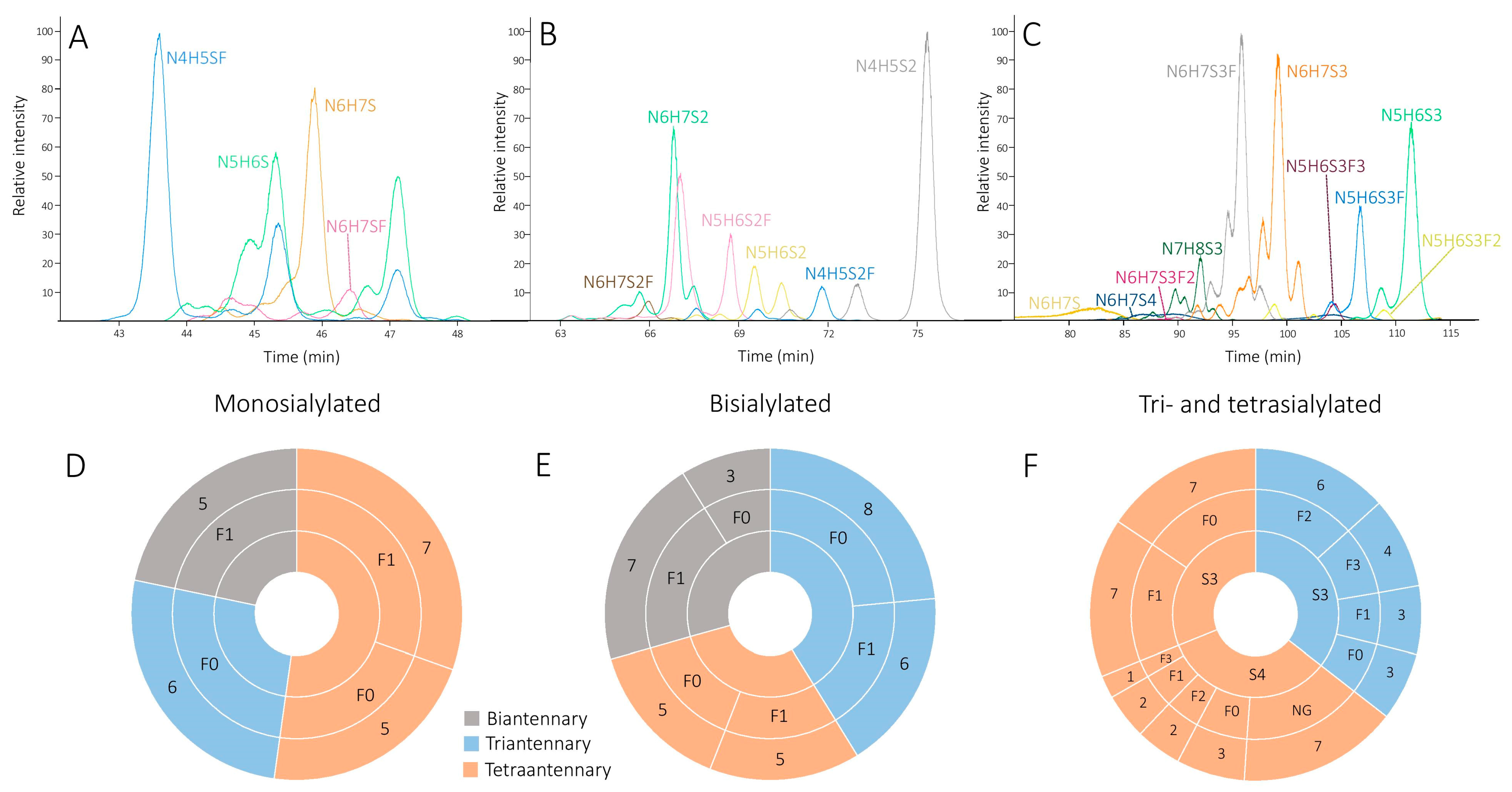
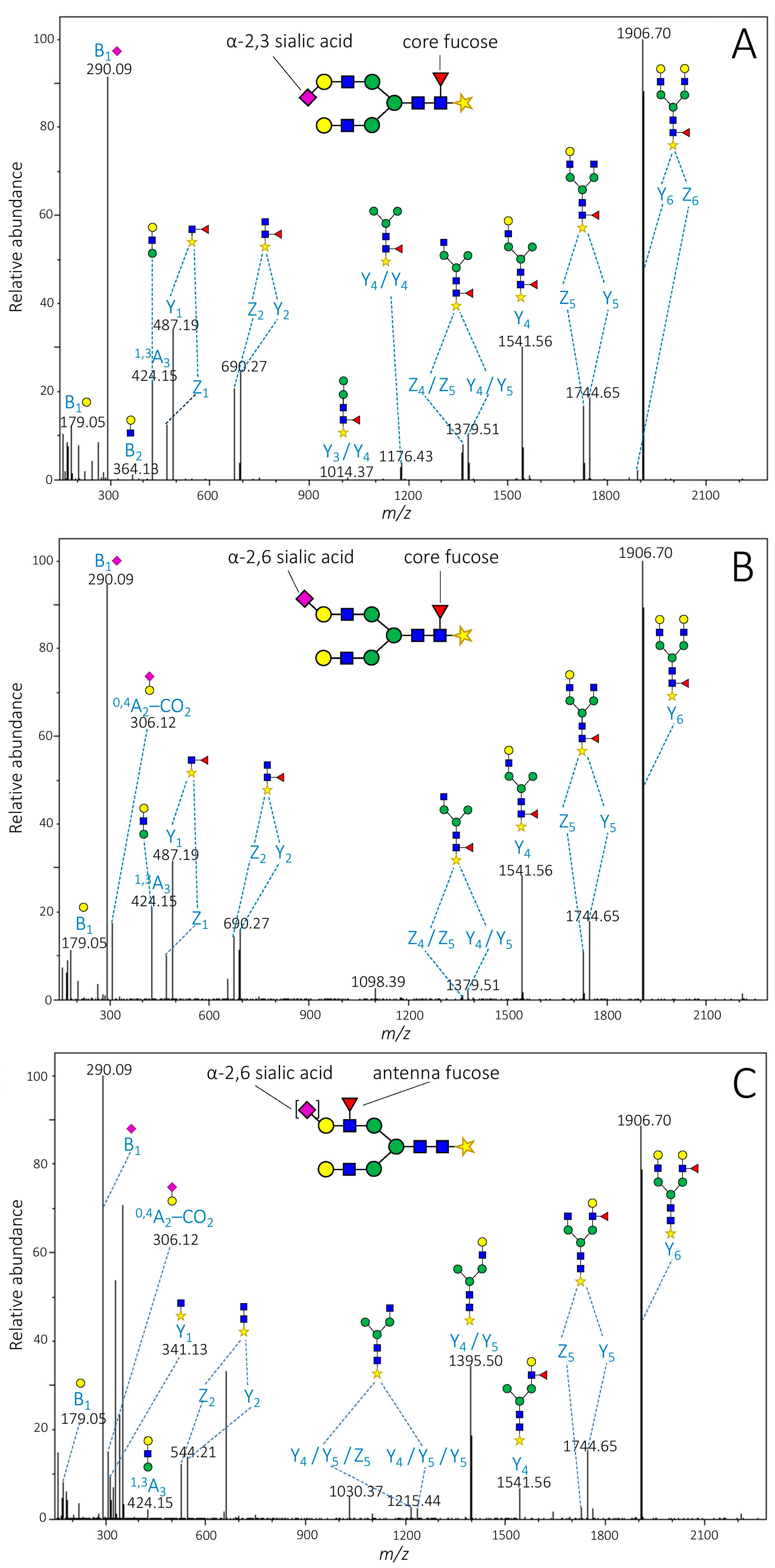
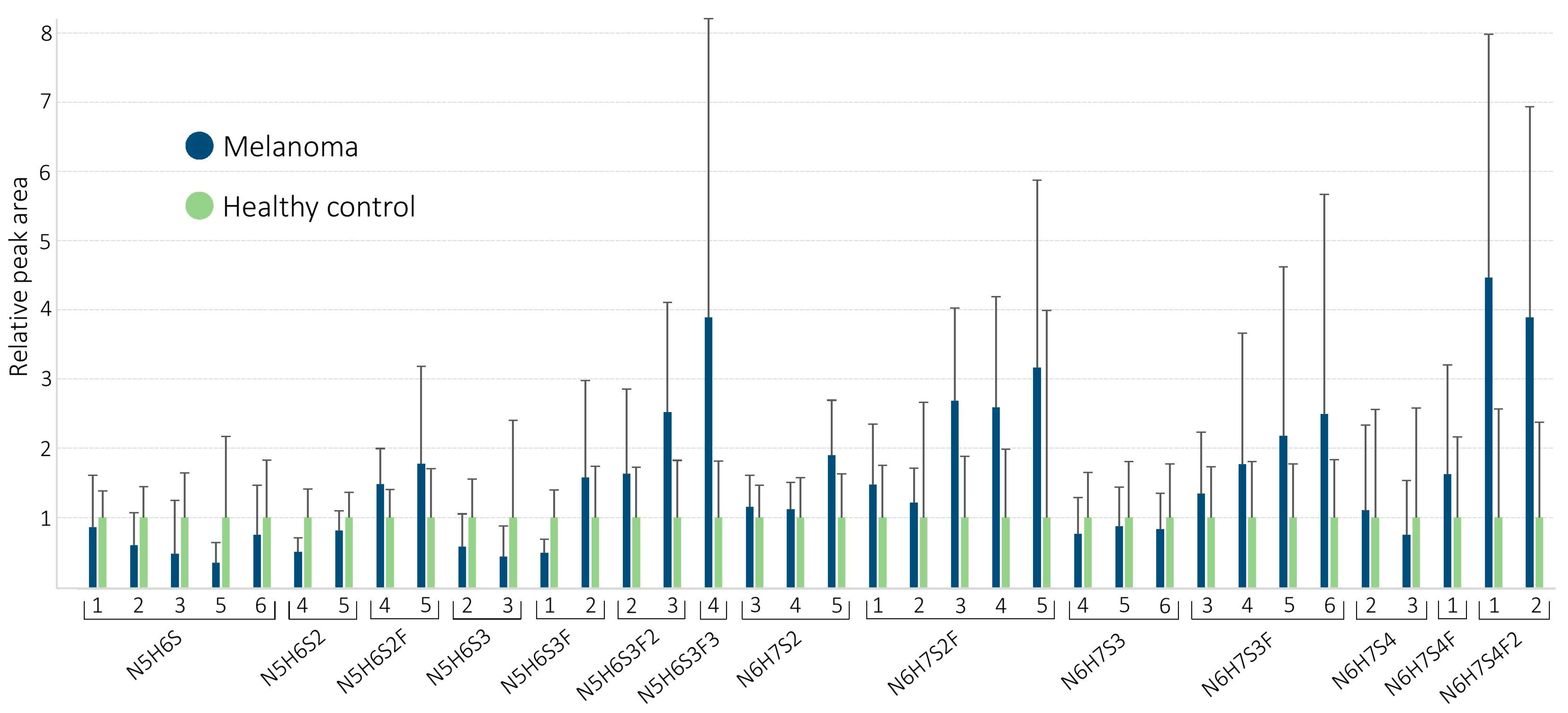
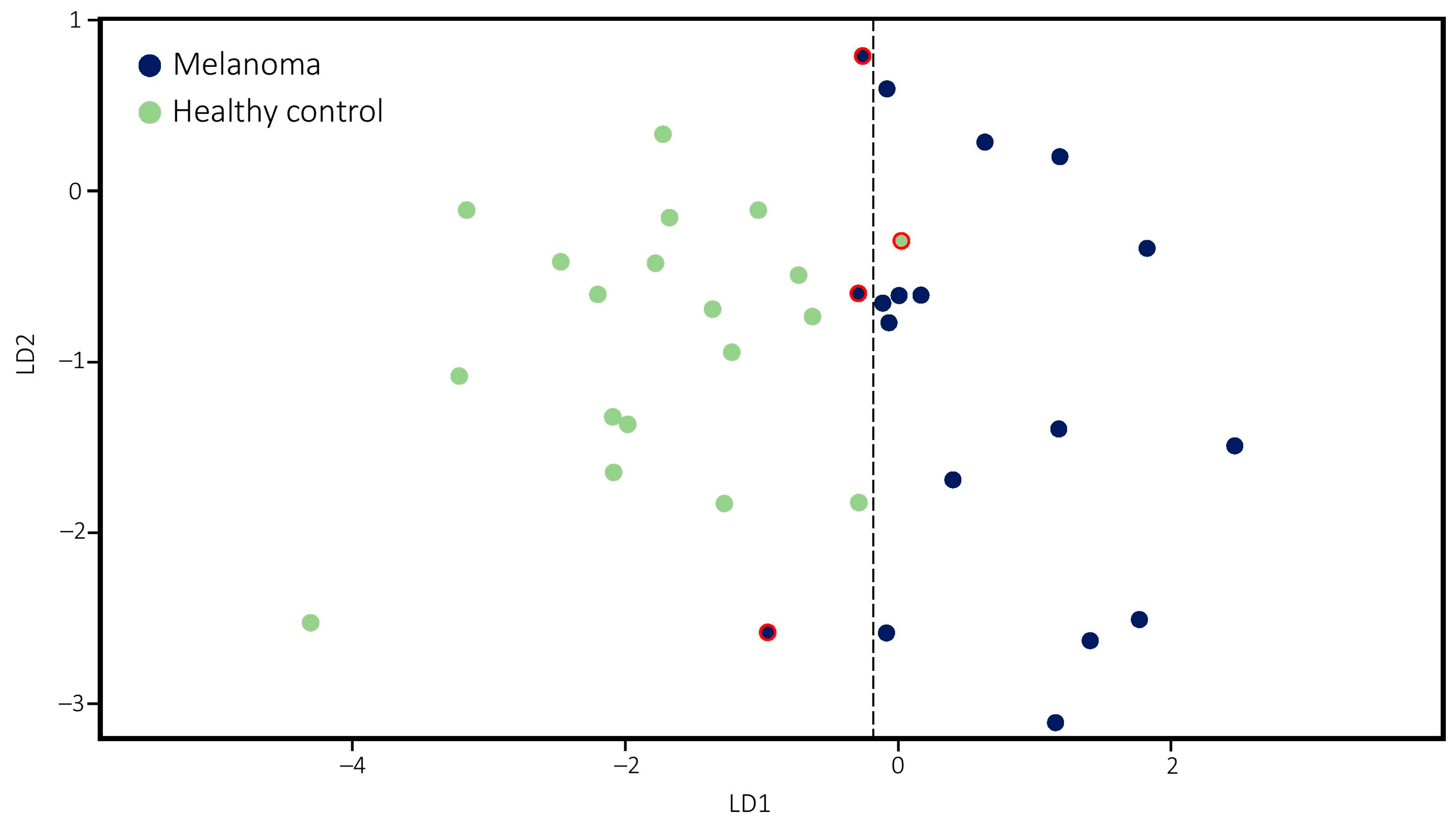
| Glycan | Discriminating Factor | Observation in MM | Fisher’s Index |
|---|---|---|---|
| N5H6S2 | Isomer 4/Isomer 5 | ↓ | 0.74 |
| Isomer 4 | ↓ | 1.20 | |
| Isomer 5 | ↓ | 0.46 | |
| All Isomers | ↓ | 0.99 | |
| N5H6S3F | Isomer 1/Isomer 2 | ↓ | 0.27 |
| N6H7S2 | Isomer 3/Isomer 5 | ↓ | 1.12 |
| Isomer 4/Isomer 5 | ↓ | 0.97 | |
| N6H7S2F | Isomer 2/Isomer 3 | ↓ | 1.23 |
| Isomer 3 | ↑ | 0.98 | |
| All isomers | ↑ | 0.85 |
| Sensitivity (%) | Specificity (%) | Positive Predictive Value (%) | Negative Predictive Value (%) | |
|---|---|---|---|---|
| S100B Protein | 33.3 | 94.7 | 85.7 | 60.0 |
| AGPC lassification | 83.3 | 94.7 | 94.7 | 85.7 |
| AGPC ross-Validation | 94.6 | 98.5 | 98.1 | 95.5 |
Publisher’s Note: MDPI stays neutral with regard to jurisdictional claims in published maps and institutional affiliations. |
© 2021 by the authors. Licensee MDPI, Basel, Switzerland. This article is an open access article distributed under the terms and conditions of the Creative Commons Attribution (CC BY) license (https://creativecommons.org/licenses/by/4.0/).
Share and Cite
Virág, D.; Kremmer, T.; Lőrincz, K.; Kiss, N.; Jobbágy, A.; Bozsányi, S.; Gulyás, L.; Wikonkál, N.; Schlosser, G.; Borbély, A.; et al. Altered Glycosylation of Human Alpha-1-Acid Glycoprotein as a Biomarker for Malignant Melanoma. Molecules 2021, 26, 6003. https://doi.org/10.3390/molecules26196003
Virág D, Kremmer T, Lőrincz K, Kiss N, Jobbágy A, Bozsányi S, Gulyás L, Wikonkál N, Schlosser G, Borbély A, et al. Altered Glycosylation of Human Alpha-1-Acid Glycoprotein as a Biomarker for Malignant Melanoma. Molecules. 2021; 26(19):6003. https://doi.org/10.3390/molecules26196003
Chicago/Turabian StyleVirág, Dávid, Tibor Kremmer, Kende Lőrincz, Norbert Kiss, Antal Jobbágy, Szabolcs Bozsányi, Lili Gulyás, Norbert Wikonkál, Gitta Schlosser, Adina Borbély, and et al. 2021. "Altered Glycosylation of Human Alpha-1-Acid Glycoprotein as a Biomarker for Malignant Melanoma" Molecules 26, no. 19: 6003. https://doi.org/10.3390/molecules26196003
APA StyleVirág, D., Kremmer, T., Lőrincz, K., Kiss, N., Jobbágy, A., Bozsányi, S., Gulyás, L., Wikonkál, N., Schlosser, G., Borbély, A., Huba, Z., Dalmadi Kiss, B., Antal, I., & Ludányi, K. (2021). Altered Glycosylation of Human Alpha-1-Acid Glycoprotein as a Biomarker for Malignant Melanoma. Molecules, 26(19), 6003. https://doi.org/10.3390/molecules26196003






